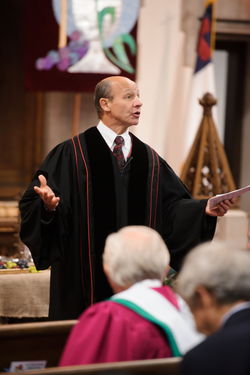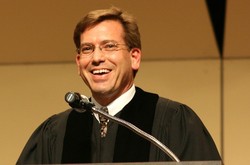In thousands of congregations the brilliant colors of fall signal the season for annual budgets, stewardship sermons and pledge cards.
For many churches it’s the only time of year financial stewardship is given high visibility. In the best-case scenario, the members pledge enough to meet the church budget, and the congregation is on its way to another year of ministry. Except for budget reports, talk about money is mostly set aside until the following autumn.
However, a growing number of congregations regard financial giving as an important part of Christian discipleship that deserves year-round emphasis.
“We and many other congregations are moving from thinking about stewardship of fundraising to encouraginglifestyles of generosity,” says the Rev. Karl Travis, pastor of First Presbyterian Church in Fort Worth, Texas. “Generosity is a spiritual virtue that is part of a larger life of discipleship.”
“You have to do the stewardship campaign, but typically that is not enough,” says the Rev. Dan Hans, pastor of Second Presbyterian Church in Lexington, Ky. Congregants, he adds, need a constant reminder of the difference their gifts are making and will make. “I heard it said years ago that money follows vision, and I think it’s true,” Hans says. “People will get excited about the vision and excited about serving Christ.”

Rev. Dan Hans
On most Sundays at Second Presbyterian, a member gives a short testimonial before the offering, telling how gifts to the church are used. Hans says topics range from children’s Sunday school to international mission trips. “I tell them to limit it to 30 seconds,” he says. “It’s not a minute for mission. It’s just a chance to say thank you.”
Travis agrees that people convinced of their church’s commitment to ministry are more generous. “Congregations need to pay mission commitments first, before they pay the pastor and the light bill,” he insists. “It’s an anti-institutional age, so congregations must practice what they preach. We must constantly remind people what the mission and ministry of the congregation are and consistently interpret that.”
Both Travis and Hans say pastors should integrate stewardship themes in their preaching throughout the year. The lectionary texts, Travis notes, often present opportunities to stress stewardship.
At Second Presbyterian, Hans emphasizes the themes of grace, gratitude, generosity and giving during the stewardship campaign and at other times. “I’ll incorporate them in sermons, pastoral prayers, prayers of confession and even in the promise of God’s assurance,” he says.
Christian education and new-member classes are also venues to underscore generosity, but Travis says financial management classes are often needed as well. “Sometimes people need to get their financial house in order first,” he says. Learning to manage money well, he explains, can help people “put their values into motion.”
Both Travis and Hans say fear is one of the biggest impediments to generosity. “The psychological challenge is to live beyond fear, which is related to the economic challenge of living a Christian lifestyle in a society that reduces our worth to what we own and tells us we need things we don’t really need,” Travis says. “The theological challenge is to trust. Do we really believe Psalm 23 when it says ‘I shall not want’?”
Uneasiness about economic circumstances can contribute to tightfistedness, Hans observes. Borrowing from 1 Corinthians 13:13, he says, “In addition to faith and love, you have to have hope.”
This article originally appeared in the Resource Guide for Ministry issue of Presbyterians Today published in March 2015.

